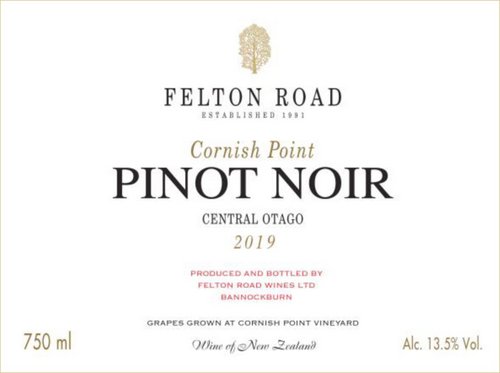Felton Road central otago Pinot Noirs – Organic and Biodynamic
There are several areas in the world that are justifiably celebrated for growing Pinot Noir grapes and for making fine wines from them. First and foremost is the home of Pinot Noir, Burgundy, France. Other areas that produce great Pinots are California, Oregon, Germany, the Alsace, Tasmania, coastal South Africa, and New Zealand.
Central Otago covers a large area of diverse soils from broken schist and clays to heavy silt loams, gravels, and light sands. Overlay that with a wide range of climatic conditions and it is easy to understand why Central Otago produces such a diverse range of Pinot Noir styles.
The distinguishing features that make many Central Otago Pinot Noirs stand out from other regional styles are impressive fruit density and a silken texture. Some also boast a Central Otago signature of wild thyme – the herb was planted in the 1850s by gold miners and now covers the hills.
Located in the South Island of New Zealand, Central Otago is very well known for its spectacular vineyards and premium quality wines. Although Pinot is the dominant grape in Central Otago, warmer sub-regions, such as Bannockburn, Bendigo, and the Cromwell Basin typically produce wines that are often described as ‘classically Central Otago’; with strong, sweet plum and cherry flavors, together with a seasoning of thyme character in some cases. Gibbstown and Wanaka tend to make cooler, edgier wines with red cherry, fresh herb, spice, and often a pronounced mineral character.
The viticultural history of Central Otago, however, goes back to the 1860s gold rush, when a Frenchman and former miner named Jean Desire Feraud planted 1,200 vines, purportedly of Pinot Noir, and made a Burgundy-style wine. His bottles won prizes at a competition in Sydney, but he couldn’t persuade the miners to give up hard liquor in favor of wine. After a few vintages, Feraud sold the property.
One person who appreciated Feraud’s efforts was Romeo Bragato, a Yugoslavian viticulturist and author of the “Report on the Prospects of Viticulture in New Zealand,” published in 1895. In his report, Bragato declared, “There is no better country on the face of the earth for the production of Burgundy grapes than Central Otago.” Bragato, like many men of his time, did not equate Burgundy with Pinot Noir; he thought it was perfectly acceptable to make “Burgundy” from Syrah.
Central Otago is now around 4700 acres of vineyards. Lively and youthful Queenstown is the wine capital of the region. Pinot Noir was planted here early on, but its acreage has increased enormously. Now 80 % of the vineyards are planted with Pinot Noir. Pinot Gris is in second place, and the rest is a smattering of Chardonnay, Riesling, and Sauvignon Blanc.
In 1987 the first wines from Central Otago were released from the three ultra-pioneers, Rippon, Gibbston, and Taramea. Felton Road was first planted in 1992. Winemaker Blair Walter joined Felton Road in 1996. One of his many adventures at the winery is going organic in 2002.
Felton Road Wines is located in Bannockburn, Central Otago in New Zealand, the most southerly wine-growing region in the World. Here, vineyards are nestled into small macroclimates totally surrounded by high mountains, many of which are snow-capped all year round.
Though the location is on the edge of sustainable viticulture these microclimates consistently combine hot days, cool nights, and long dry autumns: perfect for the creation of fine Pinot Noir, Chardonnay, and Riesling. The latitude of 45 degrees south is similar to the Willamette Valley in Oregon and some of the finest wine regions of France. Of the five distinct microclimates so far identified in Central Otago, Bannockburn, with its gentle north-facing slopes and deep loess soils seems well suited to the production of complex Pinot Noir.
Felton Road makes 150,000 bottles from 79 acres of vines. Most of it is Pinot Noir. The wines ferment in open-top tanks. Usually, Blair keeps 20-25% of whole bunches. The wines spend 12-16 months in barrel with a small percentage of new barrels. They are not fined or filtrated before bottling.
Nigel Greening, a Brit, sold his film production company and moved to Bannockburn, New Zealand, to plant the Cornish Point Vineyard. Shortly after, the owner of Felton Road, Stuart Elms, decided to sell his vineyard and winery and Greening snapped it up in 2000. Greening had been the largest private customer of Felton Road in the UK. Greening kept the team in place including winemaker Blair Walter and viticulturist Gareth King.
Felton Road Pinot Noir Bannockburn 2019
Winemaker notes: Dark raspberry, hints of the leaves as well, with a touch of old cedar wood paneling. The palate is viscous and concentrated, displaying cane fruits that deftly integrate with an alluring savouriness. Fine, long tannins with no shortage of chew, but no harshness. This is at a level way above its Bannockburn “village” designation, being a blend of our four primely situated vineyards. A serious wine with considerable definition and poise.
Felton Road Pinot Noir Calvert 2019
Winemaker notes: The characteristic aromatic florality is finely supported by mineral and spice notes on the nose. It’s seamlessly followed by a detailed palate that emphasizes precision and elegance. The tannins are evident but intricately refined and polished. The ethereal mouthfeel echos the aromatic florality with a finesse that we have come to know as unreservedly Calvert.
96 points, Suckling A very vibrant and ripe Calvert with attractively spicy oak integration, as well as abundant red and dark cherries. Super fragrant. The palate is so silky and plush, packed with concentrated, fresh red-cherry flavor. Blueberry finish. Drink or hold.



